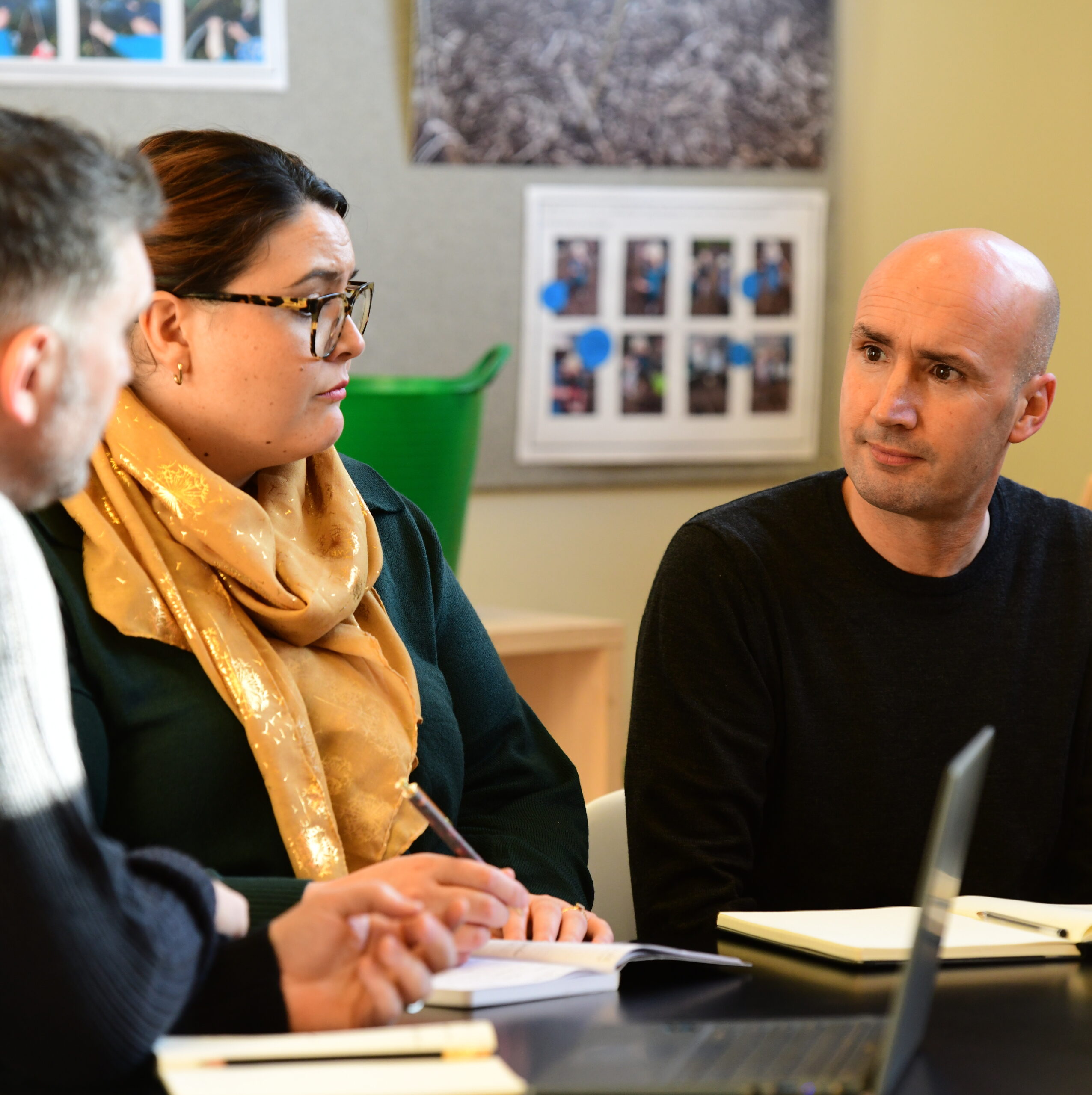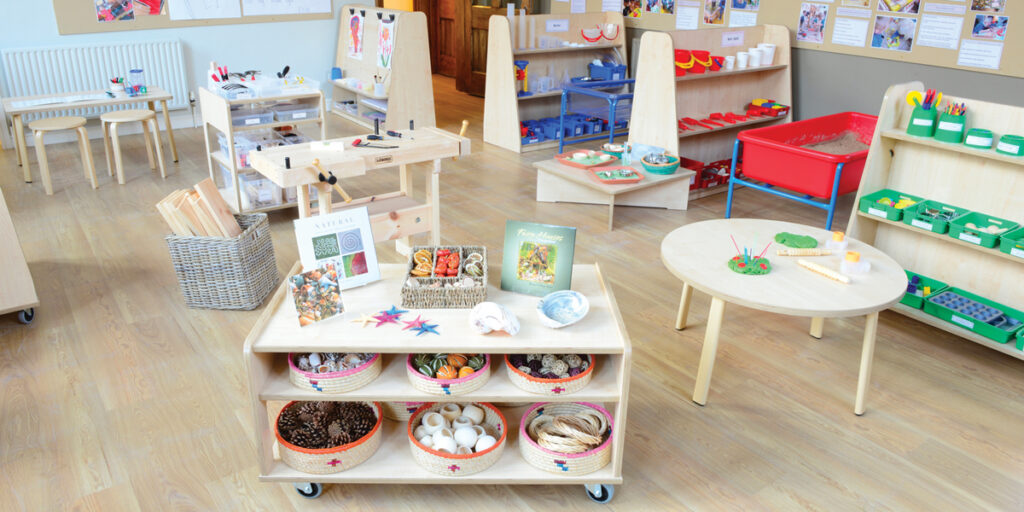How is tidy up time viewed at your school or setting? Is it seen as a race, rushing to finish tidying so that the learning can continue, or do you have a different approach? Being effective at tidy up time isn’t about speed (well, not always!) – at Early Excellence we believe it’s more about the value of the learning which takes place as part of the process.
This article is also available as a podcast:
The Daily Routine of Tidying The Classroom
With careful planning and consideration, the daily routine of tidying the classroom can run smoothly and become a meaningful way of teaching, learning and embedding a range of skills and concepts.
Here are a few suggestions to get you started:
Avoid Cluttered Areas of Provision – Offer fewer resources
Having more resources than is necessary (often too much of the same thing such as lots of sand moulds) does not necessarily lead to more effective learning. An area of EYFS provision, such as your sand or water area, if it is cluttered with too many resources causes resources to be less valued by the children and staff. Fewer resources – those that really matter – stored effectively, make it much easier to tidy away and this promotes a sense of pride in the environment.
Store Resources Effectively – Get organised and labelled
Separating out resources in each area so that it is very clear to see where each resource belongs is vital. In the small construction area, for example, you can avoid children tipping up large quantities of construction materials by making sure that they are stored in a series of smaller containers. Wheels, connecting pieces and different shaped materials are best stored separately in small individual containers so that the children can see into them and choose without tipping them up! This makes it much easier for them to get started on their ideas and also helps them to see where everything belongs when it comes to tidying up.
Consider How Resources Can be Used – Learning through tidy-up time
Some EYFS resources provide simple, but valuable, learning opportunities at tidy up time. A dustpan and brush and a long-handled brush in or near your sand area will encourage decision making and support the development of physical skills and control. Tea towels in the home corner or large sheets of fabric in your small world or small block areas, also provides physical and collaborative challenges at tidy up time, offering rich, collaborative experiences involving shape.
And in the outdoors, provided that your outdoor resources and equipment are well organised so that children, rather than just staff, can access them – there will be many opportunities for helping to tidy up at the end of the session. Storage boxes or shelves that are labelled promote reading skills and support young children’s independence – and providing photographs of each collection of the outdoor resources can be really helpful too, enabling both staff and children to put the outdoor resources away consistently each day – a really important expectation to have!
The Key Role of the Adult – Modelling & being consistent
If you ensure that adults spend time within areas of provision at tidy up time, then they can model how the resources are handled with care and how an area is tidied. Modelling how to tidy up in this way and getting children to join in and help you is much more effective than simply telling your children what to do. If the environment is well organised, this tidying away together provides lots of opportunities for exploration of shape, number, reading and new vocabulary in meaningful ways.
Being consistent as a team when naming and describing resources and materials in the classroom is an important part of the process. This consistency of language means that children hear the correct vocabulary all the time. In this way, names and properties of shapes and descriptive language linked to small world collections, for example, are embedded meaningfully as part of daily routine.
Developing Foundation Skills – Classifying, sorting & labelling
When resources are stored effectively it promotes lots of opportunities to sort, classify and discuss as part of tidy up time. How you store your small world resources, for example, provides a good example of this. By agreeing with your team the best way to group the creatures in different ways, and sharing this with your children, then at tidy up time it’s possible to have lots of discussion about habitats, younger and older, and other key features such as feathers or number of legs etc.
If you use individual labels on each storage container to clearly show what it should contain, then at tidy-up time your resources are much more likely to go back in the right place! Photographs and simple text make it easier to identify where each resource belongs. Print used meaningfully in this way is more likely to be used by the children and provides staff with an opportunity to model early reading strategies on a regular and informal basis.
Embedding Key Concepts – Templating & numbering resources
Resources such as sand tools, buckets, containers – even your wooden blocks – can be stored directly onto a shelf rather than in a container. Storing materials in this way enables easy access which is much more practical than rummaging in a box! So, don’t forget … draw around the bottom of the resources (Fablon works well for this), cut out the templates and stick them onto your shelf exactly where you want the resource to go.
For example, in your water area, if you have a set of different sized buckets, the use of circular templates will mean that each size of bucket is matched to its exact shape at tidying up. In the blocks area, you can use similar templating to show where each wooden block belongs. Children then match the shape and size of the block to the template. You can even name the templates using vocabulary such as short cylinder, tall cylinder, cuboid, half and quarter, etc – this is especially useful in KS1.
Tidy up time is also a brilliant opportunity to embed the concept of number. In the writing area, for example, you can label the number of resources that should be stored in each pot. This means that at tidy up time the children might need to find ten pencils, twelve coloured pencils and four pairs of scissors. Concepts and skills such as number recognition, counting objects accurately and exploring one more/one less can all be explored in this way.
In Conclusion – Nurturing Effective Learners
It’s the attention to detail here that’s vital.
Effective settings consider, in detail, the rich experiences involved in every part of the day, tidy up time included. It’s a time when lots of learning can take place.
It’s also a vitally important time for nurturing effective learners. The tidying away process helps children to know that everything in your classroom or setting has its place – a place where it belongs, a place where it can be found again tomorrow.
This familiarity of surroundings and consistency of resources is key in the Early Years. If we want children in the EYFS to select materials independently, have their own ideas and a sense of autonomy then planning how materials are stored is key. Also, the classroom environment provides a shared environment and should provide a sense of belonging to a community of learners. Creating a space that children take pride in, and ownership of, is crucial to nurturing this community.
Find Out More

Audit your Early Years provision with our free online audit tools, and join schools across the country who are rethinking and developing their approaches to teaching and learning.

Explore passionate discussions on early years by listening to our podcasts, designed to give EYFS & KS1 educators ideas and insights about early childhood education.

Speak to one of our Curriculum Consultants to help you with designing a new space or an existing classroom. We will work with you to discuss your vision and design your rooms to create a vibrant learning environment.

